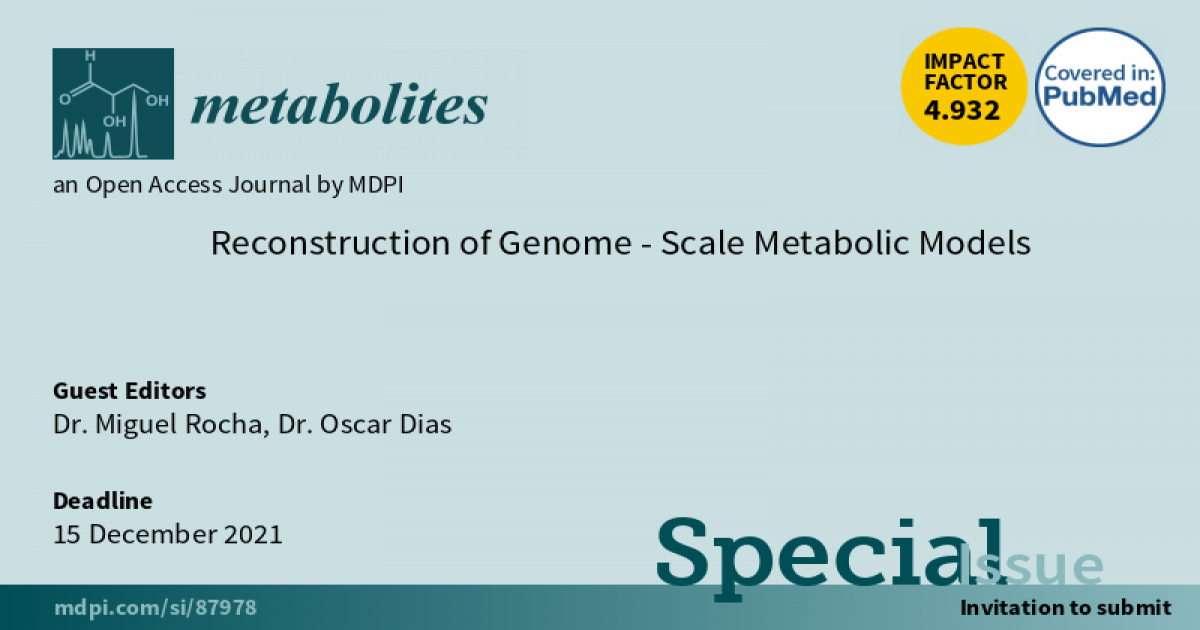Reconstruction of Genome-Scale Metabolic Models
A special issue of Metabolites (ISSN 2218-1989). This special issue belongs to the section "Bioinformatics and Data Analysis".
Deadline for manuscript submissions: closed (31 March 2022) | Viewed by 6393

Special Issue Editors
Interests: machine and deep learning; evolutionary computation; bioinformatics; systems biology; constraint-based modeling; metabolomics
Special Issues, Collections and Topics in MDPI journals
Special Issue Information
Dear Colleagues,
The organism’s phenotype reflects the outcome of the mechanisms governing the cell’s operations, which may be affected by biotic and abiotic stressors. Genome-scale metabolic models (GSMs) are a systems biology tool, commonly used in different fields of science today, from metabolic engineering in biotechnology to biomedical applications such as antibiotic discovery, metabolic disorders, or cancer research, but also addressing topics in fields such as wastewater treatment and food technology. GSMs allow understanding the organism’s metabolic response to changes in the underlying environment, but also studying phenotypes arising from genetic mutations.
In this Special Issue, we welcome submissions of manuscripts related to the reconstruction of genome-scale metabolic models and their applications. Topics that this Special Issue will cover include but are not limited to reconstruction of genome-scale metabolic models, applications of genome-scale metabolic models, combining machine learning with GSMs, novel approaches for integrating omics data with models, model and pathway visualization, and novel software tools or databases in these topics.
Manuscripts with an impact on systems biology and bioinformatics from both software developers and researchers developing and applying existing methods and computational tools to genome-scale metabolic model reconstruction and applications are welcome.
Dr. Miguel Rocha
Dr. Oscar Dias
Guest Editors
Manuscript Submission Information
Manuscripts should be submitted online at www.mdpi.com by registering and logging in to this website. Once you are registered, click here to go to the submission form. Manuscripts can be submitted until the deadline. All submissions that pass pre-check are peer-reviewed. Accepted papers will be published continuously in the journal (as soon as accepted) and will be listed together on the special issue website. Research articles, review articles as well as short communications are invited. For planned papers, a title and short abstract (about 100 words) can be sent to the Editorial Office for announcement on this website.
Submitted manuscripts should not have been published previously, nor be under consideration for publication elsewhere (except conference proceedings papers). All manuscripts are thoroughly refereed through a single-blind peer-review process. A guide for authors and other relevant information for submission of manuscripts is available on the Instructions for Authors page. Metabolites is an international peer-reviewed open access monthly journal published by MDPI.
Please visit the Instructions for Authors page before submitting a manuscript. The Article Processing Charge (APC) for publication in this open access journal is 2700 CHF (Swiss Francs). Submitted papers should be well formatted and use good English. Authors may use MDPI's English editing service prior to publication or during author revisions.
Keywords
- genome-scale metabolic models
- constraint-based modeling
- systems biology
- machine learning
- open-source software tools
- Omics data
- metabolism
- pathway visualization
Benefits of Publishing in a Special Issue
- Ease of navigation: Grouping papers by topic helps scholars navigate broad scope journals more efficiently.
- Greater discoverability: Special Issues support the reach and impact of scientific research. Articles in Special Issues are more discoverable and cited more frequently.
- Expansion of research network: Special Issues facilitate connections among authors, fostering scientific collaborations.
- External promotion: Articles in Special Issues are often promoted through the journal's social media, increasing their visibility.
- e-Book format: Special Issues with more than 10 articles can be published as dedicated e-books, ensuring wide and rapid dissemination.
Further information on MDPI's Special Issue polices can be found here.







